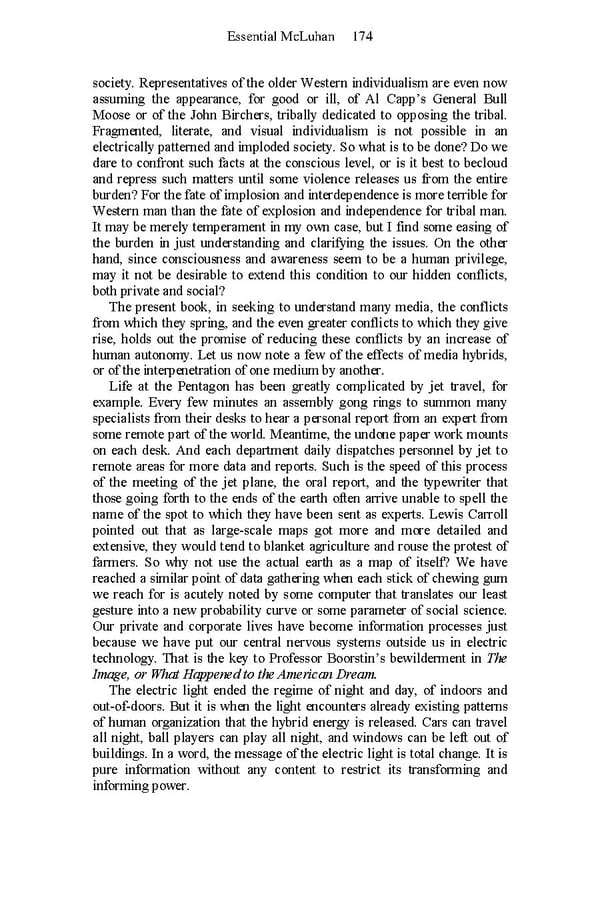Essential McLuhan 174 society. Representatives of the older Western individualism are even now assuming the appearance, for good or ill, of Al Capp’s General Bull Moose or of the John Birchers, tribally dedicated to opposing the tribal. Fragmented, literate, and visual individualism is not possible in an electrically patterned and imploded society. So what is to be done? Do we dare to confront such facts at the conscious level, or is it best to becloud and repress such matters until some violence releases us from the entire burden? For the fate of implosion and interdependence is more terrible for Western man than the fate of explosion and independence for tribal man. It may be merely temperament in my own case, but I find some easing of the burden in just understanding and clarifying the issues. On the other hand, since consciousness and awareness seem to be a human privilege, may it not be desirable to extend this condition to our hidden conflicts, both private and social? The present book, in seeking to understand many media, the conflicts from which they spring, and the even greater conflicts to which they give rise, holds out the promise of reducing these conflicts by an increase of human autonomy. Let us now note a few of the effects of media hybrids, or of the interpenetration of one medium by another. Life at the Pentagon has been greatly complicated by jet travel, for example. Every few minutes an assembly gong rings to summon many specialists from their desks to hear a personal report from an expert from some remote part of the world. Meantime, the undone paper work mounts on each desk. And each department daily dispatches personnel by jet to remote areas for more data and reports. Such is the speed of this process of the meeting of the jet plane, the oral report, and the typewriter that those going forth to the ends of the earth often arrive unable to spell the name of the spot to which they have been sent as experts. Lewis Carroll pointed out that as large-scale maps got more and more detailed and extensive, they would tend to blanket agriculture and rouse the protest of farmers. So why not use the actual earth as a map of itself? We have reached a similar point of data gathering when each stick of chewing gum we reach for is acutely noted by some computer that translates our least gesture into a new probability curve or some parameter of social science. Our private and corporate lives have become information processes just because we have put our central nervous systems outside us in electric technology. That is the key to Professor Boorstin’s bewilderment in The Image, or What Happened to the American Dream. The electric light ended the regime of night and day, of indoors and out-of-doors. But it is when the light encounters already existing patterns of human organization that the hybrid energy is released. Cars can travel all night, ball players can play all night, and windows can be left out of buildings. In a word, the message of the electric light is total change. It is pure information without any content to restrict its transforming and informing power.
 Essential McLuhan Page 180 Page 182
Essential McLuhan Page 180 Page 182